June 2, 2025 | 02:58 GMT +7
June 2, 2025 | 02:58 GMT +7
Hotline: 0913.378.918
June 2, 2025 | 02:58 GMT +7
Hotline: 0913.378.918

Mid-July torrential rain in Yok Don forest. Photo: Tung Dinh.
Yok Don is the only national park in Vietnam with a dipterocarp forest ecosystem, also known as a broadleaf forest. In the dry season (which usually lasts from November to May of the following year), the trees will change color from green to red. The leaves fall bare, leaving only thin, dry stems pointing straight to the sky.
From above looking down, the whole forest in the dry season looks like a giant brush straightening the white clouds in the Central Highlands sky.
However, as soon as the first rain falls, the heliotrope trees of Yok Don forest will revive, akin to phoenixes spreading their wings from the ashes. The dry, shriveled stems will sprout, filling large, thick, green foliage.
The vegetation below retains a burning yellow in the dry season. In the rainy season, flowers bloom across the land, together with wild turmeric, creating a scenery completely opposite the dry season.
The Central Highlands has two seasons, sunny in the dry season and wet in the rainy season. The Yok Don National Park, with an area of more than 110,000 hectares, poses challenges to forest rangers. They face not only extreme weather and difficulty preserving a large area but also measuring the flat terrain to move more easily.
On the way to Drang Phok village, it suddenly rains hard, so the driver quickly pulls over Cay Hong Ranger Station, which belongs to Ranger Station No. 6 of Yok Don National Park (Krong Na commune, Buon Don district, Dak Lak). Although we park as close to the gate as possible, the whole group still get wet because the rain was too heavy.
I quickly wipe raindrops off my shirt to walk into the ranger station. There were four people in total, two people were on patrol and two people were at the station. They brew tea in a hurry and invite us to rest on a set of chairs made of forest trees in the middle of the yard. I pull out my phone to kill some time, but there is no signal. I put the phone back in my pocket and reach for a cup of tea.
There is an old saying, “When lightning breaks, the rain comes,” which talks about the harshness of the weather. If sea lightning is fierce and explodes like firecrackers, then forest rain will be stark and torrential, blurring the entire landscape.
Watching the rain pouring water while sipping some tea, I understand what forest rain feels like. The entire sky is white; the leaves are splashed by the rain, dancing in the air. On the ground, bubbles form and pop and rain water splashes the mud as if someone was digging it up the ground.
Next to the station, an irrigation lake called Cay Hong (also known as the Drang Phok Reservoir) can irrigate about 20 hectares of rice in the village via the self-flowing method. At the ranger station, I can see a small hill, about 40-50 meters high, peeking out from the rain from the other side of the lake.
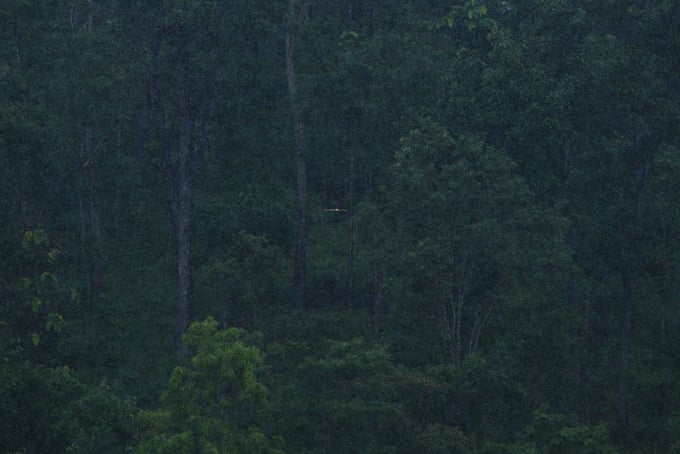
In the midst of the dark green of the forest, the 4G receiver sometimes emits a flickering red light. Photo: Tung Dinh.
Suddenly, when the rain stops momentarily, a red dot on the hillside catches my attention. To get a better look at the glowing red dot, I quickly equip my camera with a telephoto lens. I peer into the viewfinder to see it turns out to be an electronic lamp.
Curious about the lamp, I turn to ask Mr. Nguyen Van Pho, the forest ranger next to me. He says, “Everybody who comes in here asks that question. It actually bridges us to the world.” He then pulls me to the corner of the yard, pointing to a red wire near the edge of the lake, extending to the dam outside and even further.
The ranger from Binh Dinh province shares that, in the middle of the forest over 10 kilometers far from the main road, the phone signal is almost “extinct.” “Previously, it was impossible to contact the outside at the station. To get a signal, you would have to run about 5 kilometers to use the phone,” he continues.
However, during a trip to the hill on the other side, they accidentally discovered a point with a phone and even the 4G signal. To overcome the difficulty in communication, the rangers built a 4G receiver on the hill and transmit the signal to the station with a wireless transceiver in 2021.
Therefore, although the phone signal is disabled but the internet is available. After connecting to the wifi, my phone receives notifications and vibrates again and again.
The red wire Mr. Pho shows me is the power supply for the 4G receiver on the hill, which is 400-meter long, wrapping the lake via the dam’s wall. More about this receiver, the rangers call it “the acupuncture” of the 4G signal. Only a dozen centimeters off “the acupuncture,” the signal disappears.
“It looks simple but is very complicated to construct. There are no signals on the top of the hill and even fewer signals below. Only at the middle of the hill is the signal available. Other stations have “acupunctures” at the trees’ base, so we used to have to go all the way there to talk on the phone. We also have to talk through the speaker and keep the phone low, otherwise, we would be out of signal,” Mr. Pho feeds more to my curiosity.
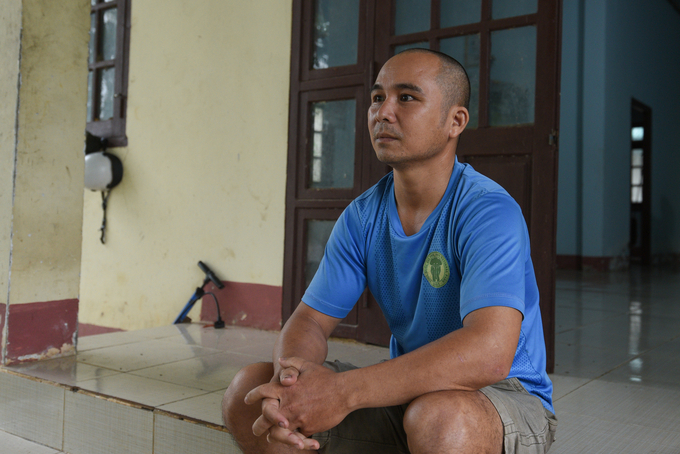
Mr. Nguyen Van Pho, a ranger at Cay Hong post of Ranger Station No. 6 of Yok Don National Park. Photo: Tung Dinh.
The Cay Hong station, in addition to 4 rangers, also has a few other special friends that are four dogs. In addition to patrolling, the rangers built a two-story barn.
In amidst the heavy rain, I see a flock of tiny chicks nestled under the wings of the mother hen. On the second floor, dozens of eggs lie neatly in a straw nest.
Pho says he has worked in forestry for 14 years since he was a garden guard in 2010. In 2012, he became a ranger and joined the Mobile Ranger Team No. 2. In 2013, he was transferred to Ranger Station No. 10, and on November 30, 2017, he returned to Ranger Station No. 6.
The forest ranger, born in 1986, says he has worked for over a decade in forestry. He is now used to staying in the forest, used to being far from home, and used to the sun and rain of the Central Highlands. “My wife is now a housewife and takes care of two kids. The older kid was born on June 1, 2013 and the younger kid was born on December 9, 2017,” Pho says.
Forest rangers in Yok Don National Park have many requirements. Firstly, the area is vast; four forest rangers are in charge of three subzones, equivalent to 3,000 hectares. In addition, unlike the dense tropical forests and rugged hills in many places, the dipterocarp forest in Yok Don is very sparse and flat.
"The hunters or loggers here can easily penetrate the woods in many ways. So the forest rangers have to spread out so that they can preserve the area,” shares the father of two. Not to mention in the rainy season, patrolling is much more difficult.
In the dipterocarp forest in the dry season, leaves falling out creates a very thick and flammable layer. Therefore, in addition to patrolling, protecting, and rangers in Yok Don, they also handle combustible materials. In short, they conduct active burning, which does not let natural fire to arise and spread from dryness or lightning strikes.

The Japanese dog is a friend of Yok Don forest rangers. Photo: Tung Dinh.
Rangers here understand that they face many challenges. For example, Pho clings to the forest from day to night to sustain the Central Highlands ecosystem.
Pho says: “My wife gave birth to our first child ten days after I joined Cay Hong station. My brother let me go home for a few days with my wife, but my dad passed away shortly. The brother again let me return home and take care of the funeral.”
Indeed, in order to live with the forest, in addition to our personal efforts, the rangers also need solidarity and compassion in the force. They only have a two-day break every two months, and going back to their family who lives 100 kilometers away already takes up all the days off.
Translated by Quynh Chi
/2025/05/29/5625-12-214801_567.jpg)
(VAN) Provincial mergers in the Mekong Delta promise to streamline administration, expand inter-provincial raw material areas, and foster close linkages in agricultural value chains, benefiting both businesses and cooperatives.
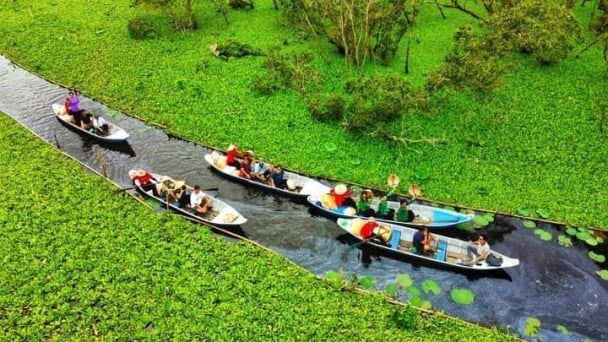
(VAN) Merging Mekong Delta provinces contributes to the expansion of agricultural raw material areas, addressing previous constraints caused by provincial boundaries. Additionally, this expansion will reduce costs and strengthen linkages between businesses, cooperatives, and farmers.
/2025/05/29/1043-2-153730_145.jpg)
(VAN) The Government's policy to merge provincial-level administrative units opens up major opportunities for the Mekong Delta region to reshape its agricultural development strategy toward large-scale production, effective regional linkages, and sustainability.
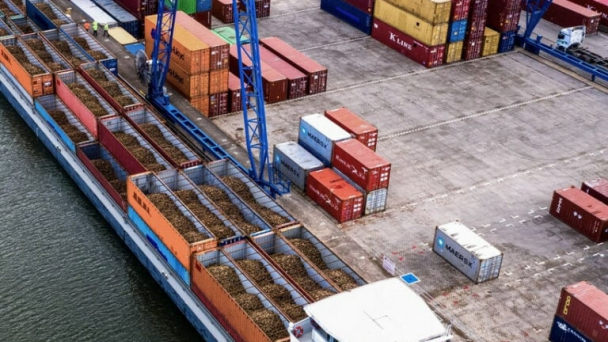
(VAN) The mutual export of agrifood products between the European Union (EU) and the United Kingdom (UK) must occur again without certification, border controls or other red tape. This was agreed at the UK-EU summit.
/2025/05/22/5121-2-173645_677.jpg)
(VAN) NBSAP Tracker identifies strengths and areas for improvement in the National Biodiversity Strategy, based on each region’s priorities and capacities.
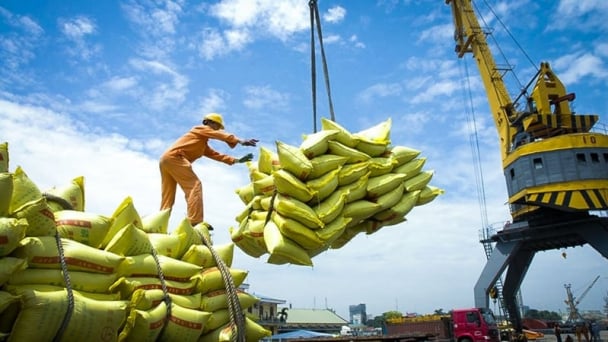
(VAN) The draft amendment to the Circular on rice export trading stipulates a periodic reporting regime for rice exporting enterprises.

(VAN) Dong Thap farmers attained an average profit margin of 64% during the summer-autumn 2024 crop (first season), while An Giang and Kien Giang farmers followed with 56% and 54%, respectively.